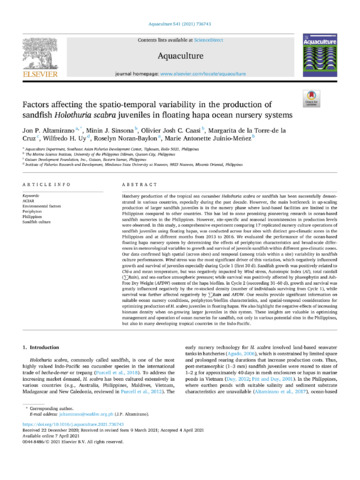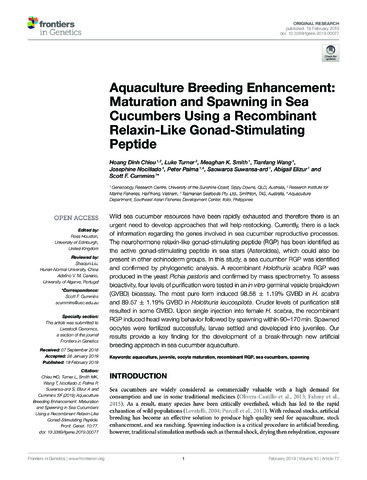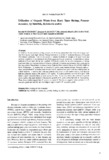Factors affecting the spatio-temporal variability in the production of sandfish Holothuria scabra juveniles in floating hapa ocean nursery systems

ดู/
Request this document
วันที่
2021-04ผู้เขียน
Page views
413เมตาดาต้า
แสดงระเบียนรายการเต็มCited times in Scopus
Share
นามธรรม
Hatchery production of the tropical sea cucumber Holothuria scabra or sandfish has been successfully demonstrated in various countries, especially during the past decade. However, the main bottleneck in up-scaling production of larger sandfish juveniles is in the nursery phase where land-based facilities are limited in the Philippines compared to other countries. This has led to some promising pioneering research in ocean-based sandfish nurseries in the Philippines. However, site-specific and seasonal inconsistencies in production levels were observed. In this study, a comprehensive experiment comparing 17 replicated nursery culture operations of sandfish juveniles using floating hapas, was conducted across four sites with distinct geo-climatic zones in the Philippines and at different months from 2013 to 2016. We evaluated the performance of the ocean-based floating hapa nursery system by determining the effects of periphyton characteristics and broad-scale differences in meteorological variables to growth and survival of juvenile sandfish within different geo-climatic zones. Our data confirmed high spatial (across site) and temporal (among trials within site) variability in sandfish culture performances. Wind stress was the most significant driver of this variation, which negatively influenced growth and survival of juveniles especially during Cycle 1 (first 30 d). Sandfish growth was positively related to Chl-a and mean temperature, but was negatively impacted by Wind stress, Autotropic Index (AI), total rainfall (∑Rain), and sea-surface atmospheric pressure; while survival was positively affected by phaeophytin and Ash-Free Dry Weight (AFDW) content of the hapa biofilm. In Cycle 2 (succeeding 31–60 d), growth and survival was greatly influenced negatively by the re-stocked density (number of individuals surviving from Cycle 1), while survival was further affected negatively by ∑Rain and AFDW. Our results provide significant information on suitable ocean nursery conditions, periphyton/biofilm characteristics, and spatial-temporal considerations for optimizing production of H. scabra juveniles in floating hapas. We also highlight the negative effects of increasing biomass density when on-growing larger juveniles in this system. These insights are valuable in optimizing management and operation of ocean nurseries for sandfish, not only in various potential sites in the Philippines, but also in many developing tropical countries in the Indo-Pacific.
การอ้างอิง
Altamirano, J., Sinsona, M., Caasi, O. J., de la Torre-de la Cruz, M., Uy, W., Baylon, R., & Juinio-Meñez, M. A. (2021). Factors affecting the spatio-temporal variability in the production of sandfish Holothuria scabra juveniles in floating hapa ocean nursery systems. Aquaculture , 541, 736743. https://doi.org/10.1016/j.aquaculture.2021.736743
เรื่อง
Taxonomic term
คอลเลกชัน
- AQD Journal Articles [1231]
รายการที่เกี่ยวข้อง
แสดงรายการที่เกี่ยวข้องตามชื่อผู้แต่งผู้สร้างและเรื่อง
-
Re-establishing the sea cucumber resources in the Philippines: The Masinloc experience
Alejandro, Marlon B. (Secretariat, Southeast Asian Fisheries Development Center, 2019)Sea cucumber of the Family Holothuriidae and Stichopodidae, is among the most commercially-exploited aquatic species in Southeast Asia in view of the increasing demand of their processed form in the international market. ... -
Aquaculture breeding enhancement: Maturation and spawning in sea cucumbers using a recombinant relaxin-like gonad-stimulating peptide
Chieu, Hoang Dinh; Turner, Luke; Smith, Meaghan K.; Wang, Tianfang; Nocillado, Josephine; Palma, Peter; Suwansa-ard, Saowaros; Elizur, Abigail; Cummins, Scott F. (Frontiers Media, 2019-02-19)Wild sea cucumber resources have been rapidly exhausted and therefore there is an urgent need to develop approaches that will help restocking. Currently, there is a lack of information regarding the genes involved in sea ... -
Utilization of organic waste from black tiger shrimp, Penaeus monodon, by sandfish, Holothuria scabra
Watanabe, Satoshi; Zarate, Jacques M.; Lebata-Ramos, Ma. Junemie Hazel; Nievales, Marie Frances J.; Kodama, Masashi (Japan International Research Center for Agricultural Sciences, 2012)In Southeast Asian countries, a large proportion of shrimp aquaculture has switched its target species from native black tiger shrimp, Penaeus monodon, to exotic P. vannamei because of frequent viral disease outbreaks. One ...






